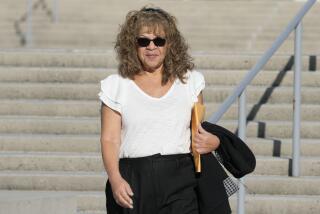Robbins Assails Letters on S & L as Phony
- Share via
SACRAMENTO — Sen. Alan Robbins (D-Tarzana) said Monday that letters that seem to implicate him in an illegal takeover of a Santa Monica savings and loan were “clear-cut fabrications” and a patently false attempt to smear him.
The letters, which contain apparent inconsistencies, were filed in U.S. District Court in Los Angeles on Friday as part of a series of motions prior to the conspiracy trial of Los Angeles businessman Michael R. Goland. Goland was charged in July with conspiring to conceal his purchase of Viking Savings & Loan from federal regulators, using money he borrowed from Robbins.
The correspondence is written as if it were an exchange of letters between Robbins and Goland, but Robbins said Monday the letters are forgeries. Goland’s lawyers, who filed the letters in court in hopes of gaining access to grand jury testimony, also said the correspondence is fraudulent.
Prosecutors have not charged Robbins in the case, describing his role solely as that of a witness.
In the first of the disputed letters, dated Dec. 20, 1987, and supposedly authored by Robbins, the writer suggests to Goland that “we need to patch up our defenses immediately” and says that the two need to avoid talking on “my regular phones” or mailing letters “at the normal addresses.”
The letter goes on to state that Robbins was taking elaborate steps to cover up his role as a principal in a secret takeover of the Santa Monica thrift.
Robbins and others familiar with the letters point out a number of chronological inconsistencies in the correspondence.
For example, there are repeated references to an investigation of Robbins by the state attorney general. The attorney general is investigating Robbins regarding allegedly questionable loans from his political campaign, but that probe was not begun until several weeks after the dates on the letters.
Robbins would not speculate on who might have prepared the allegedly fake correspondence. “I have my suspicions,” he said.
The correspondence also includes some details about Goland and Robbins that could only be known by those with a personal knowledge of the two men. For example, the letters point out that Goland worked as a checker on the docks two decades before.
The federal prosecutor in the Goland case, Assistant U.S. Atty. George B. Newhouse in Los Angeles, said he was aware of the letters and of Robbins’ contention that they had been fabricated.
Newhouse, in a phone interview, would not comment on whether he agreed that the letters are phony. He did say that the government has no intention of prosecuting Robbins in the Viking case, despite the documents.
“He is not a target of the investigation, nor a likely target,” Newhouse said. “We still view him only as a witness and expect to call him to testify at trial.”
In a separate development, Robbins’ attorneys disclosed Monday that they have challenged the recent seizure of documents from the lawmaker’s house during an FBI raid, charging that the material included memos between Robbins and his lawyers. The attorneys contend that the documents should have been protected from seizure because of attorney-client privilege.
The court-authorized search of Robbins’ Encino home Nov. 16 was part of a separate investigation of Robbins conducted by the U.S. attorney in Sacramento.
As part of a far-reaching investigation of corruption in the Capitol, FBI and IRS agents have been investigating allegations that Robbins and California Coastal Commissioner Mark L. Nathanson were part of an elaborate scheme to extort $250,000 from a San Diego hotel developer. Neither Robbins nor Nathanson has been charged with a crime, and attorneys for both men say that they have done nothing improper.
An attorney for Robbins, who asked not to be identified by name, said that if the documents were shown to have been seized improperly, that “could pollute the entire case.”
Last Wednesday--12 days after the search--Robbins’ lawyers reviewed the seized materials and had a number of the documents placed under seal until a federal magistrate can review them.
Times staff writer Kenneth Reich contributed to this article.
More to Read
Sign up for Essential California
The most important California stories and recommendations in your inbox every morning.
You may occasionally receive promotional content from the Los Angeles Times.













